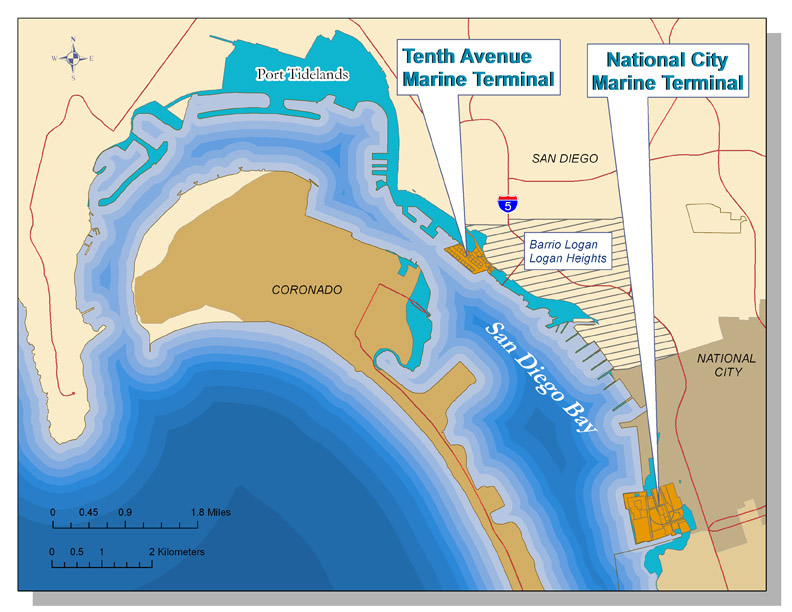
EHC supports a working waterfront and is working to make certain the Port's operations support a healthy environment.
Diesel pollution from goods movement is a major concern. According to the California Air Resources Board, goods movement related ship and truck traffic have the following health impacts in the San Diego region:
| Health Impact | 2005 Estimates | 2020 Estimates with no further controls |
| Deaths | 44 per year | 100 per year |
| Asthma-related health impacts | ||
| Asthma attacks | 860 | 2,465 |
| Lost work days | 7,630 | 14,675 |
| Restricted activity days | 51,624 | 164,360 |
| School absence days | 19,360 | 50,842 |
(2006 Emission Reduction Plan for Ports and Goods Movement in California)
In response, EHC formed United for Clean and Safe Ports in 2006, a coalition of community, health, and labor organizations, and asked the Port to:
- Reduce diesel pollution from ships docketed at all terminals
- Create a sustainable energy plan
- Reduce diesel pollution from trucks servicing the terminals through retrofits and replacement, and strict enforcement of state regulations
- Reduce diesel pollution from cargo handling equipment through retrofit and replacement.
The Port has made some progress, but EHC continues to advocate for a plan that meets all of these goals, is fully funded, and is strictly enforced.
Accomplishments
- The Port has installed shore power at the Broadway Pier cruise terminal. This allows ships to plug in to the electric grid instead of using their diesel engines for power. Shorepower at the marine terminals has not been accomplished.
- EHC secured a truck parking and idling ban on residential streets in Barrio Logan.
- Trucks leaving the Tenth Avenue Marine Terminal are not allowed to use Cesar Chavez Parkway and other streets in Barrio Logan to get to Interstate 5, but have been rerouted along Harbor Drive. The Port is working on a reconfiguration of Harbor Drive and freeway entrances that will direct trucks entering the Terminal away from residential Barrio Logan.
- The Port's and California's "truck rules" have greatly reduced the number of non-compliant trucks at the Port. Non-compliant trucks are lacking proper pollution controls.
- Cargo handling equipment has been retrofitted or replaced to reduce pollution.
- The Port is developing a Climate Mitigation and Action Plan.
Unfortunately, these actions have not yet led to decrease in diesel pollution in Barrio Logan. Possible reasons for this are the overall increase in number of truck trips to and from the Port, the use of non-compliant trucks picking up fruit cargos from a warehouse on Main Street, and trucks ignoring the ban on Cesar Chavez Parkway ban on Cesar Chavez Parkway.


 The San Diego Unified Port District was created by state legislation in 1962 to promote commerce, navigation, recreation and fisheries for most of the tidelands in the five cities around
The San Diego Unified Port District was created by state legislation in 1962 to promote commerce, navigation, recreation and fisheries for most of the tidelands in the five cities around